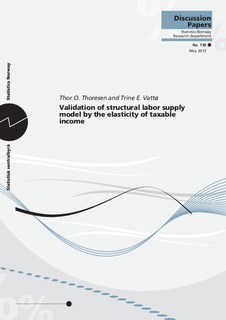| dc.contributor.author | Thoresen, Thor Olav | |
| dc.contributor.author | Vattø, Trine Engh | |
| dc.coverage.spatial | Norway | nb_NO |
| dc.date.accessioned | 2019-11-12T13:10:42Z | |
| dc.date.available | 2019-11-12T13:10:42Z | |
| dc.date.issued | 2013-05 | |
| dc.identifier.issn | 1892-753X | |
| dc.identifier.uri | http://hdl.handle.net/11250/2627967 | |
| dc.description.abstract | Given that structural labor supply models continue to play a key role in the process of policy design, it is important to validate their capacity to provide reasonable predictions of alternative hypothetical policy options. Comparing outcomes before and after a realized policy change (such as a tax reform) provides a source of information about behavioral response that can be used to certify the structural labor supply model. The elasticity of taxable income (ETI) measures the response in taxable income to a change in the net-of-tax rate and is a key concept in the quasi-experimental approach. The present paper shows how the ETI methodology can be used to validate predictions from a discrete choice structural labor supply model. Practical guidance is given on how such comparisons can be carried out, and results of these two main methods of obtaining empirical response estimates are contrasted and interpreted. | nb_NO |
| dc.description.sponsorship | Research Council of Norway | nb_NO |
| dc.language.iso | eng | nb_NO |
| dc.publisher | Statistisk sentralbyrå | nb_NO |
| dc.relation.ispartofseries | Discussion papers;738 | |
| dc.subject | JEL classification: H21 | nb_NO |
| dc.subject | JEL classification: H24 | nb_NO |
| dc.subject | JEL classification: H31 | nb_NO |
| dc.subject | JEL classification: J22 | nb_NO |
| dc.title | Validation of structural labor supply model by the elasticity of taxable income | nb_NO |
| dc.type | Working paper | nb_NO |
| dc.description.version | publishedVersion | nb_NO |
| dc.subject.nsi | VDP::Matematikk og Naturvitenskap: 400::Matematikk: 410::Statistikk: 412 | nb_NO |
